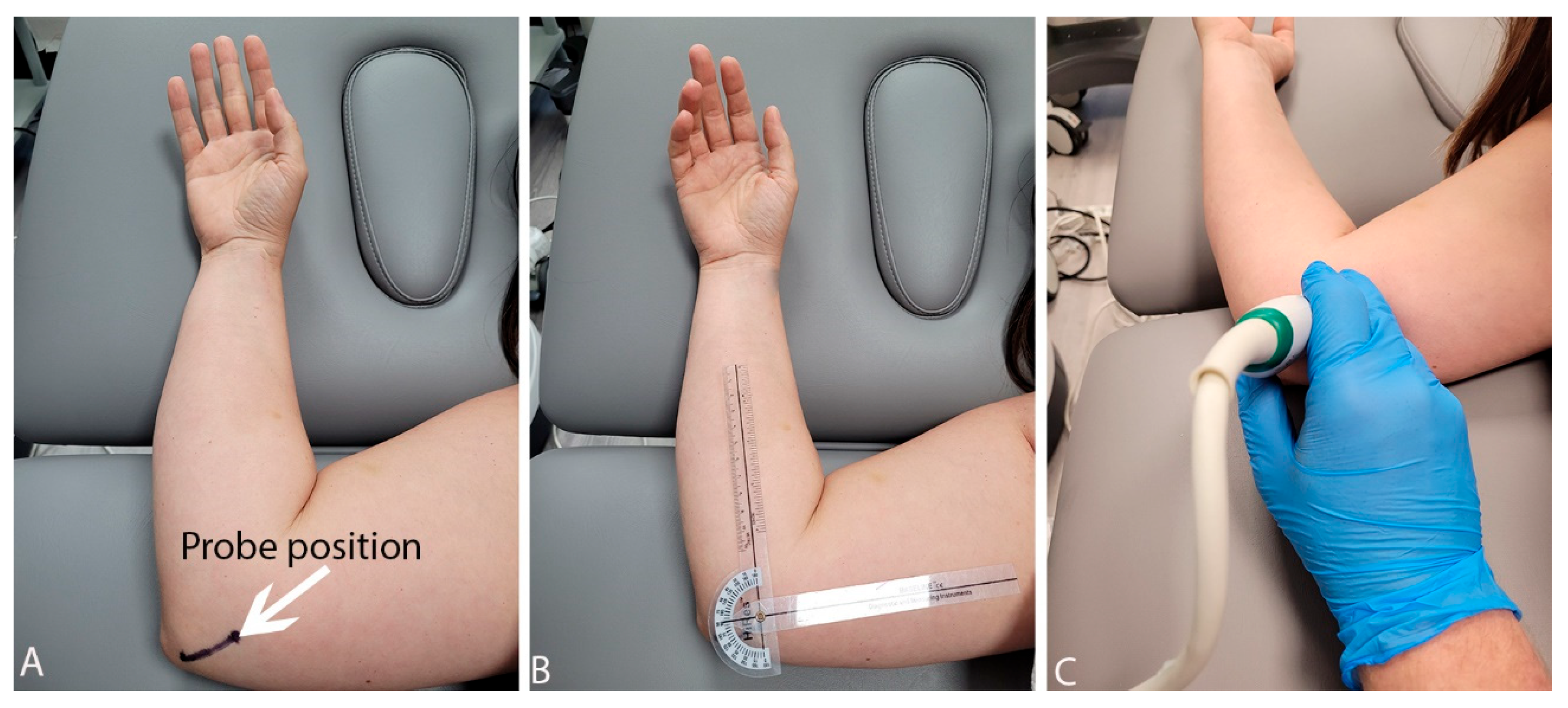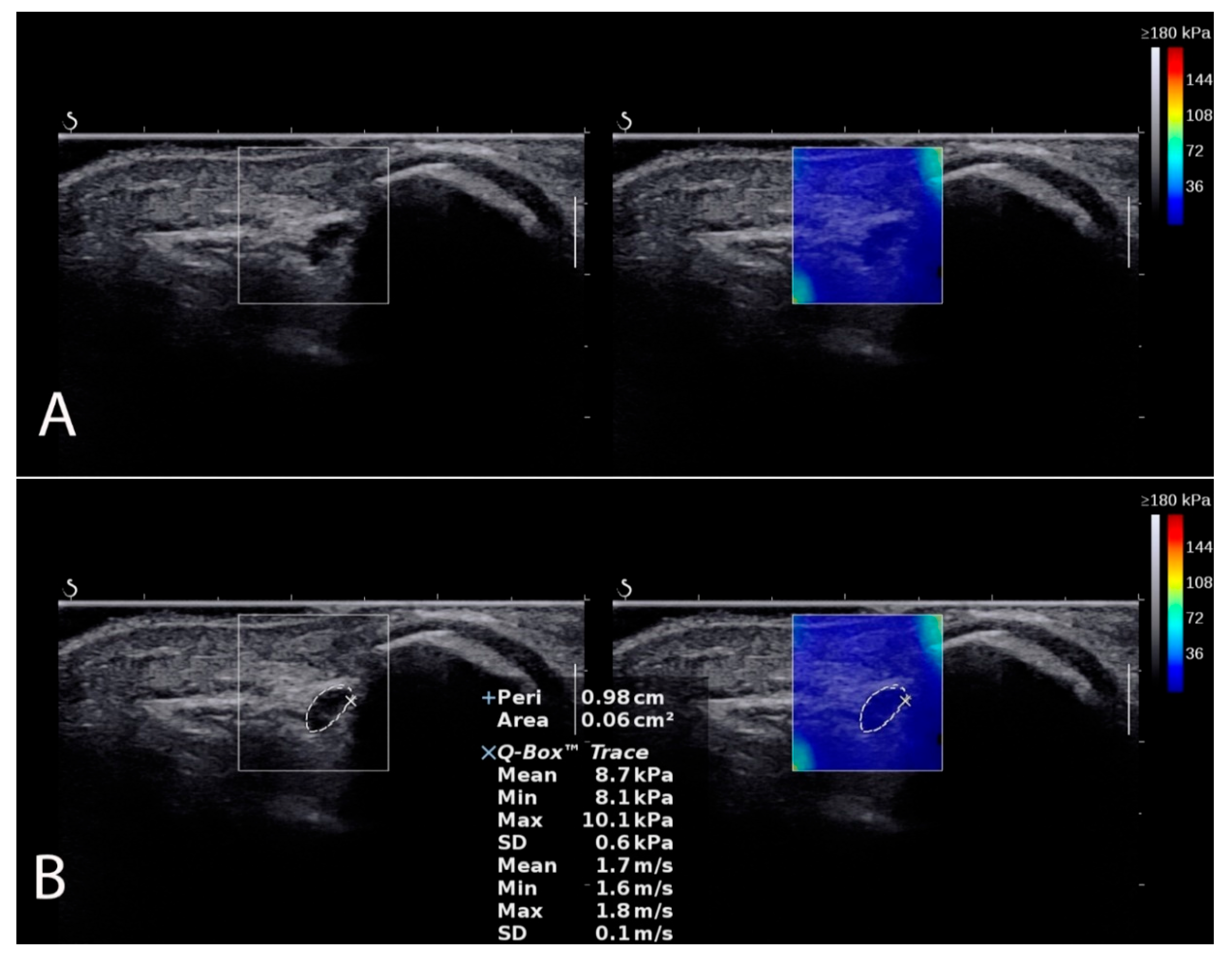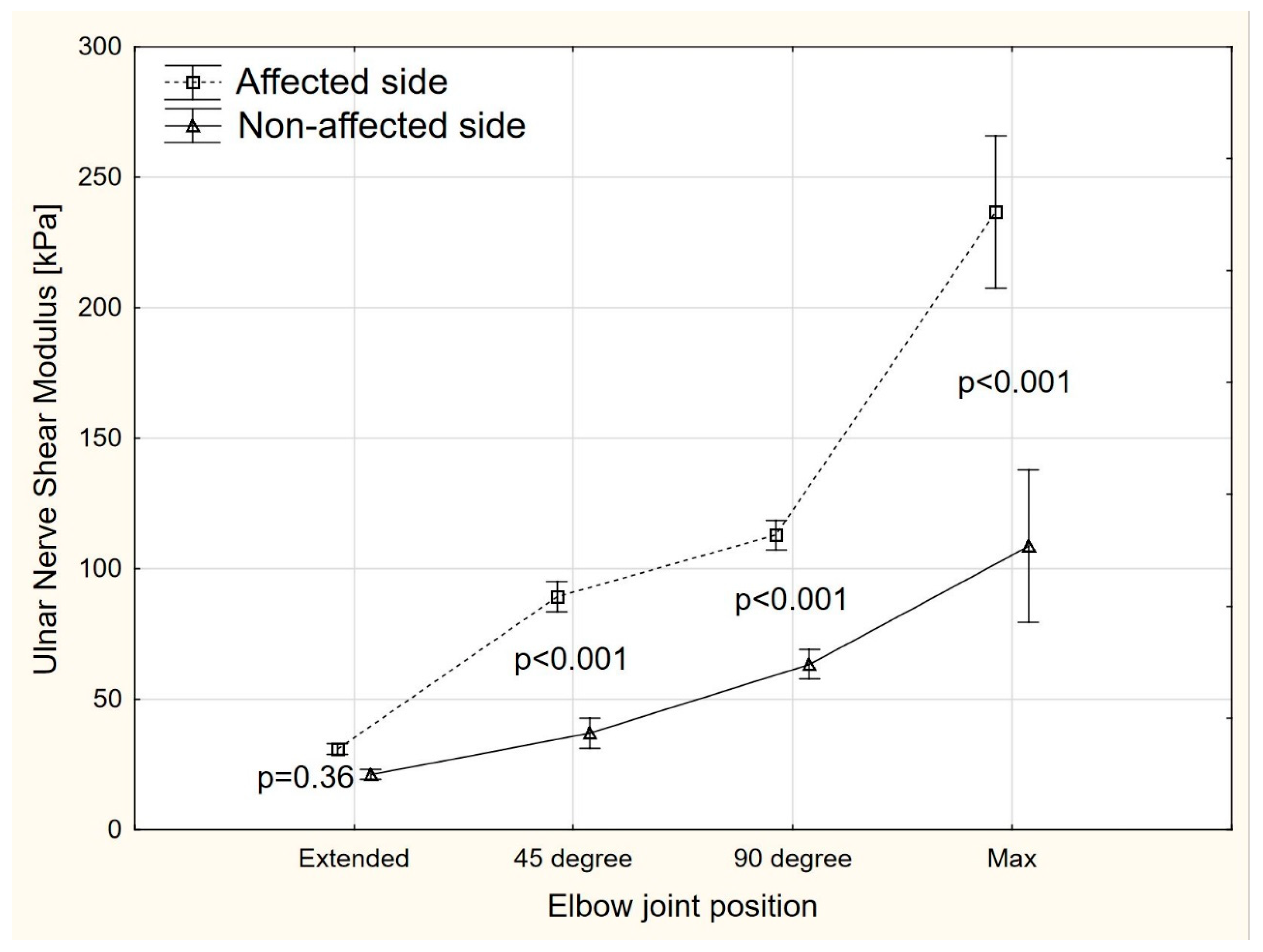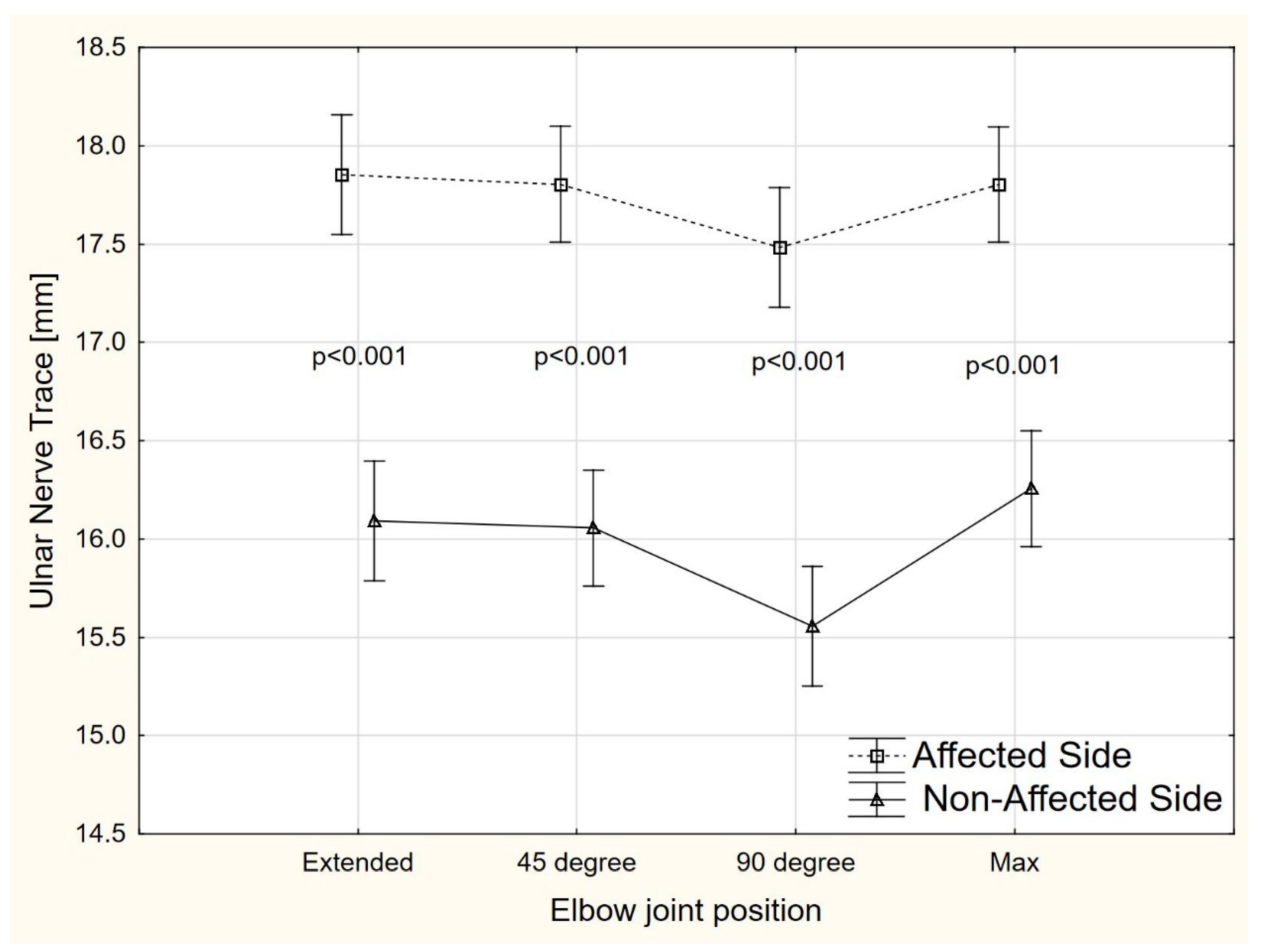Changes in Ultrasound Measurements of the Ulnar Nerve at Different Elbow Joint Positions in Patients with Cubital Tunnel Syndrome
Abstract
:1. Introduction
2. Methods
2.1. Study Design
2.2. Participants
2.3. Ultrasound Measurements
2.4. Statistical Analyses
3. Results
3.1. Characteristics of Patients with CuTS
3.2. Shear Modulus
3.3. Cross Sectional Area (CSA)
3.4. Trace
4. Discussion
5. Conclusions
Author Contributions
Funding
Institutional Review Board Statement
Informed Consent Statement
Data Availability Statement
Conflicts of Interest
References
- Elhassan, B.; Steinmann, S.P. Entrapment neuropathy of the ulnar nerve. J. Am. Acad. Orthop. Surg. 2007, 15, 672–681. [Google Scholar] [CrossRef] [PubMed]
- Robertson, C.; Saratsiotis, J. A Review of Compressive Ulnar Neuropathy at the Elbow. J. Manip. Physiol. Ther. 2005, 28, 345. [Google Scholar] [CrossRef] [PubMed]
- An, T.W.; Evanoff, B.A.; Boyer, M.I.; Osei, D.A. The Prevalence of Cubital Tunnel Syndrome: A Cross-Sectional Study in a U.S. Metropolitan Cohort. J. Bone Jt. Surg. 2017, 99, 408–416. [Google Scholar] [CrossRef] [PubMed] [Green Version]
- Wolny, T.; Fernández-de-las Peñas, C.; Buczek, T.; Domin, M.; Granek, A.; Linek, P. The Effects of Physiotherapy in the Treatment of Cubital Tunnel Syndrome: A Systematic Review. J. Clin. Med. 2022, 11, 4247. [Google Scholar] [CrossRef] [PubMed]
- Wiesler, E.R.; Chloros, G.D.; Cartwright, M.S.; Shin, H.W.; Walker, F.O. Ultrasound in the Diagnosis of Ulnar Neuropathy at the Cubital Tunnel. J. Hand Surg. 2006, 31, 1088–1093. [Google Scholar] [CrossRef]
- Kitzinger, H.B.; Aszmann, O.C.; Moser, V.L.; Frey, M. Significance of electroneurographic parameters in the diagnosis of chronic neuropathy of the ulnar nerve at the elbow. Handchir. Mikrochir. Plast. Chir. 2005, 37, 276–281. [Google Scholar] [CrossRef]
- Babusiaux, D.; Laulan, J.; Bouilleau, L.; Martin, A.; Adrien, C.; Aubertin, A.; Rabarin, F. Contribution of static and dynamic ultrasound in cubital tunnel syndrome. Orthop. Traumatol. Surg. Res. 2014, 100, 209–212. [Google Scholar] [CrossRef] [Green Version]
- Letissier, H.; Dardenne, G.; Saraux, A.; Le Nen, D.; Borotikar, B.; Jousse-Joulin, S. Ultrasound ulnar nerve measurement in a healthy population. Rheumatol. Ther. 2021, 8, 457–466. [Google Scholar] [CrossRef]
- Park, G.Y.; Kim, J.M.; Lee, S.M. The ultrasonographic and electrodiagnostic findings of ulnar neuropathy atthe elbow. Arch. Phys. Med. Rehabil. 2004, 85, 1000–1005. [Google Scholar] [CrossRef]
- Mackinnon, S.E.; Novak, C.B. Compression neuropathies. In Green’s Operative Hand Surgery, 7th ed.; Wolfe, S.W., Ed.; Churchill Livingstone: London, UK, 2017; pp. 940–947. [Google Scholar]
- Ido, Y.; Uchiyama, S.; Nakamura, K.; Itsubo, T.; Hayashi, M.; Hata, Y.; Imaeda, T.; Kato, H. Postoperative improvement in DASH score, clinical findings, and nerve conduction velocity in patients with cubital tunnel syndrome. Sci. Rep. 2016, 6, 27497. [Google Scholar] [CrossRef]
- Mezian, K.; Jacisko, J.; Kaiser, R.; Machać, S.; Steyerova, P.; Sobotova, K.; Angerova, Y.; Nanka, O. Ulnar neuropathy at the elbow: From ultrasound scanning to treatment. Front. Neurol. 2021, 12, 661441. [Google Scholar] [CrossRef]
- Lee, G.J.; Park, D. Ultrasonographic findings of the ulnar nerve following elbow flexion in patients with cubital tunnel syndrome. Pain Med. 2020, 21, 2684–2691. [Google Scholar] [CrossRef]
- Chang, K.V.; Wu, W.T.; Han, D.-S.; Ozcakar, L. Ulnar Nerve Cross-Sectional Area for the Diagnosis of Cubital Tunnel Syndrome: A Meta-Analysis of Ultrasonographic Measurements. Arch. Phys. Med. Rehabil. 2018, 99, 743–757. [Google Scholar] [CrossRef]
- Kotevoglu, N.; Gulbahce-Saglam, S. Ultrasound imaging in the diagnosis of carpal tunnel syndrome and its relevance to clinical evaluation. Jt. Bone Spine 2005, 72, 142–145. [Google Scholar] [CrossRef]
- Chen, I.J.; Chang, K.V.; Wu, W.T.; Ozcakar, L. Ultrasound parameters other than the direct measurement of ulnar nerve size for diagnosing cubital tunnel syndrome: A systemic review and meta-analysis. Arch. Phys. Med. Rehabil. 2019, 100, 1114–1130. [Google Scholar] [CrossRef]
- Chiou, H.J.; Chou, Y.H.; Cheng, S.P.; Hsu, C.C.; Chan, R.C.; Tiu, C.M.; Teng, M.M.H.; Chang, C.Y. Cubital tunnel syndrome: Diagnosis by high-resolution ultrasonography. J. Ultrasound Med. 1998, 17, 643–648. [Google Scholar] [CrossRef]
- Paluch, Ł.; Noszczyk, B.; Nitek, Ż.; Walecki, J.; Osiak, K.; Pietruski, P. Shear-wave elastography: A new potential method to diagnose ulnar neuropathy at the elbow. Eur. Radiol. 2018, 28, 4932–4939. [Google Scholar] [CrossRef] [Green Version]
- Kim, S.; Lee, G.Y. Evaluation of the ulnar nerve with shear-wave elastography: A potential sonographic method for the diagnosis of ulnar neuropathy. Ultrasonography 2021, 40, 349–356. [Google Scholar] [CrossRef]
- Gelberman, R.H.; Yamaguchi, K.; Hollstien, S.B.; Winn, S.S.; Heidenreich, F.P.; Bindra, R.R.; Hsieh, P.; Silva, M.J. Changes in interstitial pressure and cross-sectional area of the cubital tunnel and of the ulnar nerve with flexion of the elbow. An experimental study in human cadavera. J. Bone Jt. Surg. 1998, 80, 492–501. [Google Scholar] [CrossRef]
- Grewal, R.; Varitimidis, S.E.; Vardakas, D.G.; Fu, F.H.; Sotereanos, D.G. Ulnar nerve elongation and excursion in the cubital tunnel after decompression and anterior transposition. J. Hand Surg. Br. 2000, 25, 457–460. [Google Scholar] [CrossRef]
- Yoon, J.S.; Walker, F.O.; Cartwright, M.S. Ultrasonographic swelling ratio in the diagnosis of ulnar neuropathy at the elbow. Muscle Nerve 2008, 38, 1231–1235. [Google Scholar] [CrossRef] [PubMed]
- Martin, M.J.; Cartwright, M.S. A pilot study of strain elastography in the diagnosis of Carpal Tunnel Syndrome. J. Clin. Neurophysiol. 2017, 34, 114–118. [Google Scholar] [CrossRef] [PubMed] [Green Version]
- Yoshii, Y.; Tung, W.-L.; Ishii, T. Measurement of median nerve strain and applied pressure for the diagnosis of Carpal Tunnel Syndrome. Ultrasound Med. Biol. 2017, 43, 1205–1209. [Google Scholar] [CrossRef] [PubMed]
- Miyamoto, H.; Halpern, E.J.; Kastlunger, M.; Gabl, M.; Arora, R.; Bellmann-Weiler, R.; Feuchtner, G.M.; Jaschke, W.R.; Klauser, A.S. Carpal tunnel syndrome: Diagnosis by means of median nerve elasticity– improved diagnostic accuracy of US with sonoelastography. Radiology 2014, 270, 481–486. [Google Scholar] [CrossRef] [PubMed]
- Xin, H.; Hu, H.Y.; Liu, B.; Liu, X.; Li, X.; Li, J. Ultrasound elastographic evaluation of the median nerve in hemodialysis with carpal tunnel syndrome. J. Med. Ultrason. 2017, 44, 123–131. [Google Scholar] [CrossRef]
- Andrade, R.J.; Nordez, A.; Hug, F.; Ates, F.; Coppieters, M.W.; Pezarat-Correia, P.; Freitas, S.R. Non-invasive assessment of sciatic nerve stiffness during human ankle motion using ultrasound shear wave elastography. J. Biomech. 2016, 49, 326–331. [Google Scholar] [CrossRef] [Green Version]
- Dikici, A.S.; Ustabasioglu, F.E.; Delil, S.; Nalbantoglu, M.; Korkmaz, B.; Bakan, S.; Kula, O.; Uzun, N.; Mihmanli, I.; Kantarci, F. Evaluation of the tibial nerve with shear-wave elastography: A potential sonographic method for the diagnosis of diabetic peripheral neuropathy. Radiology 2017, 282, 494–501. [Google Scholar] [CrossRef] [Green Version]
- Sucher, B.M.; Schreiber, A.L. Carpal tunnel syndrome diagnosis. Phys. Med. Rehabil. Clin. N. Am. 2014, 25, 229–247. [Google Scholar] [CrossRef]
- Kutlay, M.; Çolak, A.; Şimşek, H.; Öztürk, E.; Şenol, M.G.; Topuz, K.; Demircan, M.N. Use of ultrasonography in ulnar nerve entrapment surgery: A prospective study. Neurosurg. Rev. 2009, 32, 225–232. [Google Scholar] [CrossRef]
- Thoirs, K.; Williams, M.A.; Phillips, M. Ultrasonographic measurements of the ulnar nerve at the elbow: Role of confounders. J. Ultrasound Med. 2008, 27, 737–743. [Google Scholar] [CrossRef]
- Volpe, A.; Rossato, G.; Bottanelli, M.; Marchetta, A.; Caramaschi, P.; Bambara, L.M.; Bianconi, C.; Arcaro, G.; Grassi, W. Ultrasound evaluation of ulnar neuropathy at the elbow: Correlation with electrophysiological studies. Rheumatology 2009, 48, 1098–1101. [Google Scholar] [CrossRef] [Green Version]
- Ayromlou, H.; Tarzamni, M.K.; Daghighi, M.H.; Pezeshki, M.Z.; Yazdchi, M.; Sadeghi-Hokmabadi, E.; Sharifipour, E.; Ghabili, K. Diagnostic value of ultrasonography and magnetic resonance imaging in ulnar neuropathy at the elbow. ISRN Neurol. 2012, 2012, 491892. [Google Scholar] [CrossRef] [Green Version]
- Tapadia, M.; Mozaffar, T.; Gupta, R. Compressive neuropathies of the upper extremity: Update on pathophysiology, classification, and electrodiagnostic findings. J. Hand Surg. Am. 2010, 35, 668–677. [Google Scholar] [CrossRef] [Green Version]
- Dawson, D.M. Entrapment neuropathies of the upper extremities. N. Engl. J. Med. 1993, 329, 2013–2018. [Google Scholar] [CrossRef]
- Calfee, R.P.; Manske, P.R.; Gelberman, R.H.; Van Steyn, M.O.; Steffen, J.; Goldfarb, C.A. Clinical assessment of the ulnar nerve at the elbow: Reliability of instability testing and the association of hypermobility with clinical symptoms. J. Bone Jt. Surg. Am. 2010, 92, 2801–2808. [Google Scholar] [CrossRef] [Green Version]
- Van Den Berg, P.J.; Pompe, S.M.; Beekman, R.; Visser, L.H. Sonographic incidence of ulnar nerve (sub)luxation and its associated clinical and electrodiagnostic characteristics. Muscle Nerve 2013, 47, 849–855. [Google Scholar] [CrossRef]





Publisher’s Note: MDPI stays neutral with regard to jurisdictional claims in published maps and institutional affiliations. |
© 2022 by the authors. Licensee MDPI, Basel, Switzerland. This article is an open access article distributed under the terms and conditions of the Creative Commons Attribution (CC BY) license (https://creativecommons.org/licenses/by/4.0/).
Share and Cite
Wolny, T.; Fernández-de-las-Peñas, C.; Granek, A.; Linek, P. Changes in Ultrasound Measurements of the Ulnar Nerve at Different Elbow Joint Positions in Patients with Cubital Tunnel Syndrome. Sensors 2022, 22, 8354. https://doi.org/10.3390/s22218354
Wolny T, Fernández-de-las-Peñas C, Granek A, Linek P. Changes in Ultrasound Measurements of the Ulnar Nerve at Different Elbow Joint Positions in Patients with Cubital Tunnel Syndrome. Sensors. 2022; 22(21):8354. https://doi.org/10.3390/s22218354
Chicago/Turabian StyleWolny, Tomasz, César Fernández-de-las-Peñas, Arkadiusz Granek, and Paweł Linek. 2022. "Changes in Ultrasound Measurements of the Ulnar Nerve at Different Elbow Joint Positions in Patients with Cubital Tunnel Syndrome" Sensors 22, no. 21: 8354. https://doi.org/10.3390/s22218354




